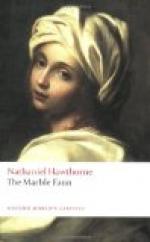But, indeed, she was not quite in a normal state. Emerging from gloom into sudden cheerfulness, the effect upon Hilda was as if she were just now created. After long torpor, receiving back her intellectual activity, she derived an exquisite pleasure from the use of her faculties, which were set in motion by causes that seemed inadequate. She continually brought to Kenyon’s mind the image of a child, making its plaything of every object, but sporting in good faith, and with a kind of seriousness. Looking up, for example, at the statue of St. Michael, on the top of Hadrian’s castellated tomb, Hilda fancied an interview between the Archangel and the old emperor’s ghost, who was naturally displeased at finding his mausoleum, which he had ordained for the stately and solemn repose of his ashes, converted to its present purposes.
“But St. Michael, no doubt,” she thoughtfully remarked, “would finally convince the Emperor Hadrian that where a warlike despot is sown as the seed, a fortress and a prison are the only possible crop.”
They stopped on the bridge to look into the swift eddying flow of the yellow Tiber, a mud puddle in strenuous motion; and Hilda wondered whether the seven-branched golden candlestick,—the holy candlestick of the Jews, which was lost at the Ponte Molle, in Constantine’s time, had yet been swept as far down the river as this.
“It probably stuck where it fell,” said the sculptor; “and, by this time, is imbedded thirty feet deep in the mud of the Tiber. Nothing will ever bring it to light again.”
“I fancy you are mistaken,” replied Hilda, smiling. “There was a meaning and purpose in each of its seven branches, and such a candlestick cannot be lost forever. When it is found again, and seven lights are kindled and burning in it, the whole world will gain the illumination which it needs. Would not this be an admirable idea for a mystic story or parable, or seven-branched allegory, full of poetry, art, philosophy, and religion? It shall be called ’The Recovery of the Sacred Candlestick.’ As each branch is lighted, it shall have a differently colored lustre from the other six; and when all the seven are kindled, their radiance shall combine into the intense white light of truth.”
“Positively, Hilda, this is a magnificent conception,” cried Kenyon. “The more I look at it, the brighter it burns.”
“I think so too,” said Hilda, enjoying a childlike pleasure in her own idea. “The theme is better suited for verse than prose; and when I go home to America, I will suggest it to one of our poets. Or seven poets might write the poem together, each lighting a separate branch of the Sacred Candlestick.”
“Then you think of going home?” Kenyon asked.
“Only yesterday,” she replied, “I longed to flee away. Now, all is changed, and, being happy again, I should feel deep regret at leaving the Pictorial Land. But I cannot tell. In Rome, there is something dreary and awful, which we can never quite escape. At least, I thought so yesterday.”




